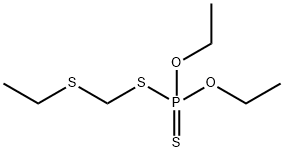Phorate

|
| Manufacturer | Product number | Product description | Packaging | Price | Updated | Buy |
|---|
Properties
Melting point :-43°C
Boiling point :125-127°C (2 mmHg)
Density :d425 1.156
vapor pressure :8.5×10-2 Pa (25 °C)
refractive index :nD25 1.5329
storage temp. :0-6°C
solubility :Chloroform (Slightly), Ethyl Acetate (Slightly), Methanol (Slightly)
Water Solubility :0.005 g/100 mL
BRN :1708517
Exposure limits :ACGIH TLV: TWA 0.05 mg/m3 ppm, STEL 0.2 mg/m3
Stability :Stable. Incompatible with strong oxidizing agents.
CAS DataBase Reference :298-02-2(CAS DataBase Reference)
NIST Chemistry Reference :Phorate(298-02-2)
EPA Substance Registry System :Phorate (298-02-2)
Boiling point :125-127°C (2 mmHg)
Density :d425 1.156
vapor pressure :8.5×10-2 Pa (25 °C)
refractive index :nD25 1.5329
storage temp. :0-6°C
solubility :Chloroform (Slightly), Ethyl Acetate (Slightly), Methanol (Slightly)
Water Solubility :0.005 g/100 mL
BRN :1708517
Exposure limits :ACGIH TLV: TWA 0.05 mg/m3 ppm, STEL 0.2 mg/m3
Stability :Stable. Incompatible with strong oxidizing agents.
CAS DataBase Reference :298-02-2(CAS DataBase Reference)
NIST Chemistry Reference :Phorate(298-02-2)
EPA Substance Registry System :Phorate (298-02-2)
Safety Information
| Symbol(GHS): |
 
|
||||||||||||||
|---|---|---|---|---|---|---|---|---|---|---|---|---|---|---|---|
| Signal word: | Danger | ||||||||||||||
| Hazard statements: |
|
||||||||||||||
| Precautionary statements: |
|
Description
Phorate is a kind of widely used organophosphate pesticide and acaricide1-2. It is a powerful pesticide effective against insects, mites, and nematodes3. It is a systemic insecticide that acts by inhibiting cholinesterases, enzymes involved in transmitting nerve impulses. However, it is very toxic both for target organisms and for mammals including human1-2. Because of its persistence in soil it is most useful in controlling soil-dwelling nematodes (microscopic roundworms that suck plant roots and transmit disease thereby). It is not recommended for use by the homeowner because it is extremely toxic and persistent3.Related product price
- Acetonitrile
₹423-3194650 - Mefenpyr-diethyl
₹7200-14600 - 2-Butanone oxime
₹1500-6938.83






